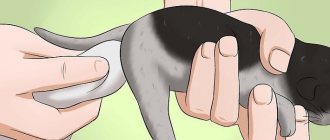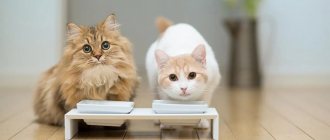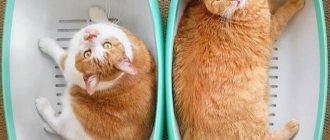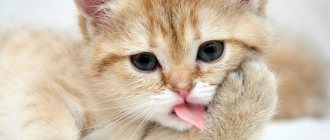The idyll between a pet and a person may one day be disrupted by one extremely delicate but global problem: the furry creature begins to completely or partially ignore the toilet. In return, the cat finds another or several other places, which first leads the owner into panic, then into rage. If the cat has stopped going to the litter box, this fact, due to the owner’s insensitivity and unwillingness to understand the problem, can one day lead to a painful separation from the animal, which equally traumatizes all participants in the situation.
As a rule, there are two reasons why a cat stopped going to the toilet: behavioral (psychological) and medical.
Therefore, do not rush to give up on your furry, because despite all the complexity, the problem can be solved if you show maximum sensitivity, observation and understanding, and, most importantly, love for your pet. After all, giving up the usual toilet is also a serious stress for him. Felines, with all their cleanliness, conservatism, attachment to territory and “rituals,” will never just abandon their favorite litter box. This happens because something is bothering them. Why did the cat stop going to the litter box? There may be several reasons, which are conditionally divided into 2 categories: behavioral (psychological) and medical.
If your cat stops going to the litter box, start monitoring her behavior.
The first ones are so diverse that sometimes it is very, very difficult to guess the source of the “shift”. The latter are more serious, because health problems always mean concern for the pet, long-term treatment (the outcome of which is unpredictable), and expenses. But the toilet problem can be solved, and this must be clearly understood. So let's deal with everything in order.
Analysis of reasons with a tray and a cat
Experts conventionally identify two etiological factors for litter box refusal: behavioral and medical. The first category includes various psychological problems and emotional stress. The medical factor includes the presence of any disease in the pet.
Behavioral approach
From a psychological point of view, the most common reason for refusing a litter box is a dislike of the litter. In this case, changing the product to another eliminates the problem, and the pet stops pooping in the wrong place. In addition, an animal may choose a certain place, even if there is no cat litter box there.
Refusal to use the toilet can occur if it is heavily soiled and has a pronounced unpleasant odor.
A pet may refuse to use the tray if there is a stranger in the house. At the same time, the cat experiences significant stress and chooses secluded places for the toilet.
A common factor in changing a pet's behavior is the arrival of a new animal in the house. In this case, the refusal to go to the toilet in a certain place is explained by the development of stress and conflict with the new pet.
Emotional stress affects the psychological state of a cat. If the owner constantly swears at the pet in a raised voice or uses physical force as punishment, the animal may not only ignore the tray, but also refuse food.
A problem with the toilet may arise when moving to a new living space, since the usual odors are absent, and the process itself has a stressful effect on the pet.
Medical point of view
There are a large number of somatic pathologies and physiological processes that lead to the fact that the pet ceases to relieve itself in a specially designated place.
Going to the toilet in the wrong place sometimes accompanies a period of estrus, during which the hormonal levels in the pet’s body change. In this case, sterilizing the animal can eliminate this problem.
Diseases of internal organs are often accompanied by urinary incontinence, dysuric disorders and other pathologies. Most often, the reason for refusing the tray is inflammatory diseases of the genitourinary system - urolithiasis, urethritis, cystitis. Due to the resulting inflammation of the mucous membrane, the animal cannot restrain the urge to urinate, as a result of which bowel movements occur in the wrong place. The symptom is also observed in intestinal diseases, hepatitis, endocrine diseases, allergic reactions and other pathologies.
Involuntary bowel movements may signal the onset of intestinal disease due to inflammation or disruption of its structure. These pathologies include colitis, megacolon, intestinal infections, poisoning and other diseases.
In old age, the sphincter muscles may weaken, causing the cat to stop using the litter box due to incontinence.
Psychological reasons
This group includes any factors affecting the psychological state of the animal. In addition to severe stress and other emotional turmoil, an unfamiliar smell can cause a dislike of the bathroom.
Didn't like the new tray or filler
If you recently changed the tray to a different model, then most likely it’s all about the strong smell of plastic and the absence of cat marks. Also, the pet may be confused by the appearance of the product if the purchased toilet is fundamentally different from its previous version.
Changing the filler also evokes similar feelings. Flavored options are only good for humans. Mustached pets smell much more keenly, so the scent of flowers only scares them away.
Dissatisfaction may also be explained by the consistency of the filler. Highly absorbent silica gel granules crunch very loudly when instilled, causing fear or irritation to the animal.
Rearranging the place where the pot is located
Small changes or major renovations to the washroom can be a big turn-off for your pet. Combining a toilet with a bathroom is especially difficult. Most cats hate water, so moving their potty to a potentially dangerous location will feel like a challenge to find a new litter box in another part of the house.
The appearance of a new smell in the cat's latrine
Another reason for the appearance of a new smell is moving. Having lost its usual trail, the cat simply will not understand where exactly it should go to the toilet.
Your pet may also be put off by an automatic air freshener. Unlike the usual one, it will leave a pleasant aroma in the room on a permanent basis. Despite its convenience, this device can cause allergies or severe stress in your pet due to sudden spikes.
Being distracted by a sharp sound at a crucial moment is not the most pleasant development of events. Don’t be surprised if the cat will bypass the toilet with this scary device a mile away - and do its business behind a more harmless sofa.
Lack of privacy
The location of the toilet plays a significant role. It’s easy to understand that it’s very, very difficult to concentrate when people are constantly looking at you or distracted by extraneous sounds. An open door, noisy company and proximity to household appliances are not the best solution for comfortable emptying of the bladder.
Revenge, resentment, severe stress
By defecating past the tray, animals take revenge for an insult. If you raised your hand to your pet or scolded it after several hours from the moment of committing a bad act, then it will only remember your cruelty. Such parenting methods never bring anything good, so try to abandon them so as not to spoil the relationship.
Another possible cause of resentment is lack of attention. Owners who spend a lot of time at work often forget to play with their pets. And if another pet or child appears in your home, then the existing resentment will only increase.
The choice of a more secluded corner can also be explained by severe stress. It occurs when changing place of residence, after a recent trip to the veterinarian or an unpleasant hygiene procedure. The cat may also be worried about a large number of strangers gathered in the house.
Furnishings and smell, toilet filler
In order for a cat to go to the toilet in a certain place, it is important to choose the right location and filler. If the pet does not like the location of the tray and the means that absorbs feces, the animal may shit in the wrong place.
Experts recommend placing the tray in a secluded place, where people are present as little as possible and there are no sources of loud sounds. In addition, it is important that the cat is comfortable sitting in the tray, so its location should be in an easily accessible place.
The contents of the toilet should not be dirty or smell bad, so you should wash the container and change the filler on time. But when training your pet to go to the toilet in a certain place, you should take into account that the animal is guided by the smell, so if the cat shits in the wrong place, use a napkin to blot the feces and put it in the tray. When cleaning the toilet, you should not use household chemicals that have a strong odor, as this may scare away your pet.
Main reasons
- Urolithiasis is characterized by the formation of stones in the urethra and kidneys. The etiological factor in the occurrence of the disease is poor nutrition, a sedentary lifestyle, excess weight, prolonged abstinence from urination due to a dirty tray, and diseases of the genitourinary system. The clinical picture is represented by painful urination, while the cat produces a small amount of urine, and incontinence is characteristic as a result of reflexive relaxation of the sphincter when pain occurs. In addition, stones can injure the mucous membrane, resulting in the presence of blood in the urine. Most often, cats under 7 years of age are susceptible to the disease.
- Urethritis is inflammation of the urethra. The disease develops against the background of a long course of urolithiasis, sterilization, infection with pathogens, and trauma. It is painful for a cat to urinate; the animal empties its bladder in the wrong place, since the urge to urinate is accompanied by severe pain.
- Cystitis is inflammation of the mucous membrane of the bladder. As a rule, the etiological factor is bacterial infection. The cat's urination becomes more frequent, pain is observed, and a small amount of urine is released, down to drops.
- Colitis is a fairly common intestinal disease, with the formation of an inflammatory process in the large intestine. The cause of the disease can be improper feeding of the pet, activation of opportunistic intestinal microflora against the background of a weakened immune status or undergoing a course of antibiotic therapy, helminthiases, allergies, intestinal infections, injuries. The clinical manifestation is increased frequency of bowel movements, abnormal stool, and the pet may go to the toilet in the wrong place.
- Intestinal infections - damage to the intestines by specific pathogens. The animal suffers from nausea, vomiting, and diarrhea. There may be a rise in temperature.
- Megacolon is an anomaly in which the large intestine increases in size as a result of impaired smooth muscle tone. The causes of the disease have not been fully studied. Experts believe that the etiological factor may be genetic predisposition, intestinal trauma as a result of ingestion of solid foreign bodies, trauma to the pelvis, impaired muscle tone as a result of frequent constipation and deliberately restraining the urge to defecate due to a dirty tray.
- With age, various dystrophic changes occur in all organs and tissues. Thus, the muscles of the sphincters of the genitourinary system and gastrointestinal tract are weakened, which leads to the fact that an old cat can shit in the wrong place.
- Contamination of the litter box is a common reason why a pet may defecate anywhere in the living space. Cats are clean animals that love clean conditions, so a large amount of excrement in the toilet, as well as the strong unpleasant odor emanating, can cause disgust in the pet. It is necessary to wash the tray regularly. In addition, poor litter box maintenance can result in your pet resisting the urge to defecate. This can lead to the formation of dangerous diseases.
- In some cases, a cat may walk past the litter box if it doesn't like the litter. In this case, the pet may find the smell of a clean and dirty product unpleasant, as well as its appearance. In this case, it is advisable to change the filler or cover it with a special grill. This reason can be suspected if the animal does not have any somatic diseases and the psychological status is not impaired.
- Your pet may not like the tray. In this case, the cat will stubbornly ignore it and defecate past the toilet. Changing the tray usually solves the problem.
- Cats are very sensitive to smells. If a strong, unpleasant odor of urine or feces emanates from the toilet, a clean pet will refuse to relieve itself in such a tray. A problem may also arise if the owner washes the container with strong-smelling household chemicals. The synthetic smell will also cause disgust in the animal. In addition, the use of such products is dangerous due to the occurrence of an allergic reaction.
- Placing the litter box in a place where there are often people and loud noises is a common reason for a cat to refuse to go to the toilet. This is due to the psychological characteristics of the animal. Pets love secluded places where they can relieve themselves without the observation of strangers.
- Estrus and sexual heat in males is a period when a change in hormonal levels occurs in the animal’s body, and, consequently, its behavior. In this case, the pet may begin to mark the territory and defecate next to the tray. As a rule, behavior changes occur periodically, according to the sexual cycle.
- Many cats are characterized by vindictiveness. At the same time, according to experts in the field of veterinary psychology, most often cats pee past the litter box as revenge, that is, they do it out of spite.
- Jealousy in a pet occurs when a new animal appears in the house. In this case, the cat is trying to attract attention. Therefore, when buying a new pet, you should not forget about your old friend.
- Emotional stress occurs due to many factors - moving to a new apartment, injury, illness, aggressive behavior on the part of the owner.
Wrong filler
Cats are self-sufficient and fastidious animals. Often the reason that a pet categorically refuses to go to the litter tray is that the owner does not like the litter chosen by the owner. At the same time, even in the filler he doesn’t like, he will still write.
This is explained by the fact that the animal spends much less time on the process of urination than on defecation. Therefore, if the cat is uncomfortable with its paws immersed in the litter for some time, it will walk past the tray. It is easy to solve this problem - just change the type of cat litter.
Why doesn't a cat want to go to the litter tray in a small or large way?
If your pet stops going to the litter box, a disease of the genitourinary system should be suspected. The most common cause is urolithiasis. The same situation can arise after sterilization of an animal. There may be a case of abstaining from urination due to improper care of the tray.
If an animal begins to walk around in the wrong place, you need to think about the presence of problems with the gastrointestinal tract or emotional stress. In addition, the cause may be incorrectly selected food.
The place for the tray is not secluded
For a cat, going to the toilet is a very important and intimate ritual. The tray must be placed in such a place that the kitten does not feel prying eyes when relieving itself. An animal sitting on a tray may be frightened by conversations, laughter, noise, or the curiosity of children or a dog. Therefore, the kitten’s latrine should be secluded and inaccessible to children and other animals. For this purpose, many people make a special hole in the toilet door or buy a closed toilet for cats. However, the easiest way is to explain to your household that you should not chase your cat when it goes to the toilet. You also need to teach the dog not to approach the kitten's litter box.
Mr. Cat Recommends: Re-training to the Litter Box
To eliminate the problem of a cat refusing the litter box, it is necessary to diagnose the animal. To do this, it is recommended to consult a veterinarian and carry out all the necessary research. Once a diagnosis has been made and treatment has been prescribed, toilet training can begin again.
If your pet begins to avoid the litter box due to pain when urinating as a result of a disease of the genitourinary system, the animal may develop a negative reflex, so it is recommended to replace the container with a new one.
If your cat is used to defecating in the same place, you can wean the animal off using special sprays that block the odor.
You should accustom your pet to the litter box according to the same principle as kittens - when signs of a desire to empty the bladder or intestines appear, you need to put the pet in the toilet. The procedure is repeated again and again until the animal begins to relieve its natural needs in the tray on its own.
In some cases, the cat does not accept any tray, then you can try to teach her to use the toilet. For this, there are special training systems that can be purchased at a pet store.
What to do if your cat stops going to the litter box
First, observe your pet to determine the reason for its behavior. In most cases, you can handle the problem on your own. A veterinarian's help will only be required if a disease is detected.
Cause Calculation
First of all, it is recommended to make sure that there are no pathologies. The main symptoms of urological diseases include:
- plaintive meowing or rumbling when trying to urinate, indicating acute pain;
- the smell of rot and ammonia from excreted urine;
- fever and general weakness, expressed by increased drowsiness, apathy and refusal to eat;
- frequent urination with a gradual reduction in the volume of discharge;
- the appearance of blood and pus in the urine, as well as a change in its color;
- sharp pain when palpating the bladder.
If the only warning signs you observe are poor appetite and weak activity, then most likely your pet is experiencing increased anxiety. In this case, it is recommended to eliminate the provoking factors and try to pay more attention to it.
While maintaining the frequency of urination and the volume of urine excreted, the loss of cleanliness is explained by harmless psychological reasons, territorial instinct and erratic hormones. In the first two cases, education and reshuffling will help you, and in the last - sterilization or castration.
Please note that taking hormonal drugs that suppress sexual activity should be avoided. They provide only temporary relief and are often accompanied by even more serious complications.
Treatment of urological diseases
If you are convinced that the cat began to pee in the wrong litter box due to illness, simply follow the veterinarian’s recommendations. Cleanliness will return on its own after recovery.
The treatment method will depend on the disease:
- Cistit
. The urethra is cleaned with a catheter with antibiotics and antiseptics. Its artificial emptying is carried out only in an emergency. All other drugs depend on the accompanying symptoms and the cause of inflammation.
- ICD
. Accumulated stones are destroyed surgically, catheterization or changing the diet. If a secondary infection is detected, the animal undergoes a course of antibiotic therapy.
- Urethritis
. Treatment for this disease is similar to cystitis. The mustachioed patient is prescribed antibiotics and diuretics to destroy the pathogen and stabilize urination.
- Atony
. The main method of treatment is catheterization. If a prostate tumor is detected, surgery is performed. In other cases, it is recommended to undergo a course of massage and manual stimulation of the bladder at certain hours.
A therapeutic diet is also mandatory. It involves a reduced intake of proteins and fats. Animals on dry food are transferred to specialized feed. Their regular use normalizes the flow of urine, reduces the number of stones and reduces the load on the liver and kidneys.
How to solve a problem with a tray - the best ways
If an animal refuses the litter box during estrus or heat, it is recommended to castrate the pet. This procedure causes the cat to stop defecating outside the litter box. However, there is a relationship between sterilizing a pet and an increased risk of developing inflammatory diseases of the urinary system.
Experts recommend cleaning the toilet once every two days using soap. You cannot completely get rid of the smell, as its absence will lead to the pet not recognizing the toilet. With regular cleaning of the litter box, as a rule, pets stop defecating in the wrong place.
If your pet does not like the tray or filler, you should replace it with a new one. In addition, the reason for refusing to go to the toilet may be the rug on which it stands. The litter can absorb unpleasant odors, as drops of urine fall on it, in which case you should get rid of it.
Adult cats
In mature individuals, problems with bowel movements are associated with a large number of possible complications. The most common among them are as follows:
Hairballs stuck in esophagus
Since cats periodically lick themselves, it is naive to think that all the “eaten” fur leaves the animal’s body unhindered. On the contrary, this fluff tends to compact and block the intestines, making it problematic not only to get rid of feces, but also to form them. To help your cat digest fur, it is advisable to add grass to his diet. We talk about what other methods you can resort to to help your cat clear the esophagus of hair below.
Helping your cat cough up fur
Inactive lifestyle
The functioning of digestion largely depends on physical activity, and if your pet is a couch potato, then you should not even dream of a well-coordinated functioning of the gastrointestinal tract. To balance the metabolism and normalize the process of digesting food, it is necessary to pay attention to the pet and engage it in games that require movement.
Normally, domestic carnivores must move a lot to digest the food they eat.
Hunting season
During sexual arousal, uncastrated animals experience a hormonal surge that radically changes their daily habits. Cats may refuse to eat, and, as a result, refuse to use the litter box simply because they are driven by other goals and do not notice their “base” needs while searching for a partner. As already mentioned, the only way to avoid the urge to mate in cats is to castrate them on time.
Loss of appetite and the urge to bowel movement is typical for both males and females during sexual heat











